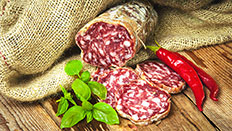Meats and Sausages
Salame Cremona
Salame Cremona is Italian salami produced in Lombardy, Emilia Romagna, Piedmont and Veneto regions of Italy. Salami Cremona PGI has deep red color, a typical spicy fragrance and must weigh not less than 500 g (1.1 lb) after maturing, diameter of not less than 65 mm when prepared (stuffed), length of not less than 150 mm when prepared (stuffed).
| Meats | Metric | US |
|---|---|---|
| Lean pork (shoulder) | 700 g | 1.54 lb |
| Back fat | 300 g | 0.66 lb |
Ingredients per 1000g (1 kg) of meat
| Salt | 28 g | 5 tsp |
| Cure #2 | 2.5 g | 1/2 tsp |
| Pepper | 2.0 g | 1 tsp |
| Black peppercorns | 2.0 g | 1 tsp |
| Dextrose | 3.0 g | 1/2 tsp |
| Sugar | 3.0 g | 1/2 tsp |
| Garlic, smashed | 7.0 g | 2 cloves |
| Red wine | 5 ml | 1 tsp |
| T-SPX culture | 0.12 g | use scale |
Instructions
- Grind lean pork through 1/4” (6 mm) plate.
- Dice fat into 1/4” (6 mm) cubes.
- 30 minutes before mixing dissolve starter culture in 1 tablespoon de-chlorinated water.
- Mix lean pork with salt and cure #2. Add spices, wine and culture. Mix. Add diced fat and mix all together.
- Stuff firmly into 65 mm natural casings.
- Ferment at 20º C (68º F) for 72 hours, 90-85% humidity.
- Dry at 15→12° C (59→53° F), 65-75% humidity for 6 weeks.
- Store at 10-12° C (50°-55 F), 75% humidity.
Notes
History
The production of Salame Cremone is very closely linked with local pig breeding establishments, which go back to Roman times. The main historical documents, which provide clear and specific evidence of the origin of the product and its link with the region, date back to 1231 and are preserved in the Cremona State Archive. They confirm trade between the territory of Cremona and neighboring states in pork and meat products. A series of Renaissance documents in the ‘Litterarum’ and ‘Fragmentorum’ of the state.
Archive prove conclusively not only the presence but also the importance of salame in the area identified in the specification. Reports drafted when Bishop Cesare Speciano (1599-1606) visited the convents mention in the section on ‘day-to-day life’ that ‘on days when meat is eaten’ a certain quantity of salame was also distributed. Even today, the traditional presence of Salame Cremona is gaining in importance in the main agricultural and food fairs of Lombardy and the Po Valley. Socio-economic references demonstrate the presence of a large number of producers engaged in the processing of pork in the plain of the Po, an industry which spread thanks to its integration with the dairy and cheese industry and cereal growing (especially maize).
The geographical area of production
The raw materials for the product must come from pigs born, raised and slaughtered in one of the following regions: Friuli-Venezia Giulia, Veneto, Lombardy, Piedmont, Emilia-Romagna, Umbria, Tuscany, Marche, Abruzzi, Lazio and Molise. The pigs are sent for slaughter between the end of their ninth month and their 15th month. The average weight of each individual sent for slaughter must lie between 144 and 176 kg.
Production
Meat: pork shoulder, leg trimmings (ham part), jowls, belly. Mechanically recovered meat is prohibited.
Ingredients: salt, spices, peppercorns, roughly ground pepper, garlic. The following may also be used: white or red wine, sugar and/or dextrose and/or fructose and/or lactose, starter culture, sodium and/or potassium nitrite, ascorbic acid and sodium erythorbate.
Processing: The pieces of muscle and fat are carefully trimmed, with removal of the larger bits of connective tissue, soft fat, lymph nodes and nerves. The meat is ground with 6 mm (1/4”) plates. During mincing, the meat must be at a temperature higher than 0° C (32° F). Salame Cremona is packed into natural porcine, bovine, equine or ovine casings of an initial diameter of 65 mm or more. The sausage is manually or mechanically reinforced with butcher twine. The product may be kept in storage chambers for up to one day at a temperature between 2 - 10° C (5 - 50° F). The product is warm-dried for a few days at 15 - 25°C (59 – 77° F). Drying/maturing takes place in premises where there is adequate air circulation at a temperature between 11 - 16 °C (52 – 60° F) for a period of at least five weeks. The period of maturing varies, according to the diameter of stuffed sausage: 65 -75 mm - 35 days, 86-90 mm – 80 days, 96-100 mm – 100 days.


















